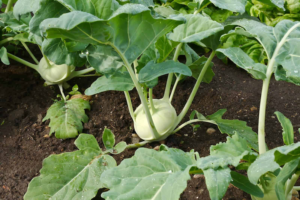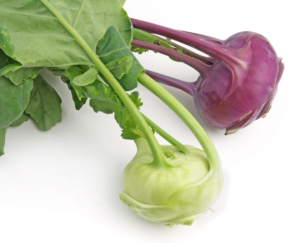“What’s that strange looking thing?” —most people looking at a kohlrabi.
Actually, the strangest thing about kohlrabi is that it isn’t grown more than it is. The flavor is most often compared to “peeled broccoli stems, but milder and sweeter.” It is another of the vegetables on the “Best for Health” list.


Benefits and nutritional information:
- Nutritionally, kohlrabi is considered a superfood; nutrient-rich and low in calories.
- One cup of raw kohlrabi provides 140% of the RDI of Vitamin C.
Starting:
-
Seeds can be sown when the soil temperature reaches 55 degrees. Sow them 1/2 inch deep, 1” apart.
When to plant:
- Kohlrabi requires 45 to 60 days to reach maturity. Plantings should be times to harvest them before daytime temperatures reach 75 degrees.
- When warmer temperatures do arrive, kohlrabi will stop growing and will bolt.
- Sowing kohlrabi in late summer can provide a winter harvest.
Thinning, training
- Plants should be spaced from 5 to 8 inches apart in rows 18 to 24 inches apart.
- Thinned seedlings can be transplanted to another part of the garden.
Signs of over-watering, nutrient deficiency
- Kohlrabi that is too slow growing to mature in time may be suffering from nutrient deficiency. While they require a balanced fertilizer, the plant is most susceptible to a deficiency of nitrogen.
- Overwatering leads to root rot.
Pests and pest controls
- Since Kohlrabi is another of the brassicas, a vital part of pest control is to avoid planting it where other brassicas were grown in the past two seasons. Especially Clubroot and black rot diseases in the soil can be a problem.
- Damping off is one of the most common problems when starting plants from seeds.
- Although the same pests that like cabbage can also attack kohlrabi, it is generally less troubled by aphids, root maggots, cabbageworms, and other caterpillars.
Harvesting
- Harvest kohlrabi when leaves are 2.5 to 4 inches wide.
- The bulb is the most commonly eaten part of the plant, but the leaves are also edible.
